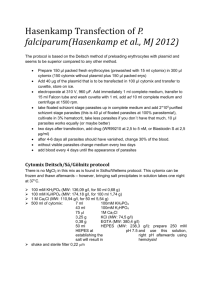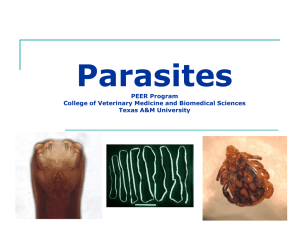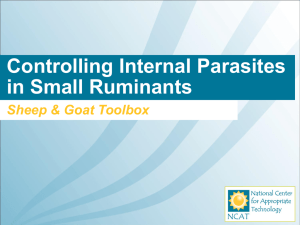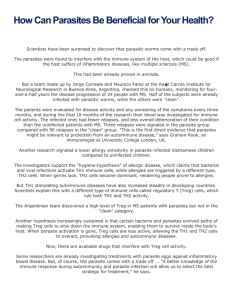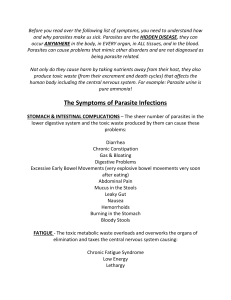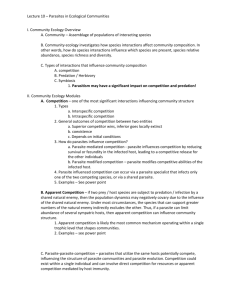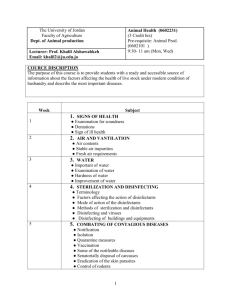Parasite Rex - Gustavus Adolphus College
advertisement
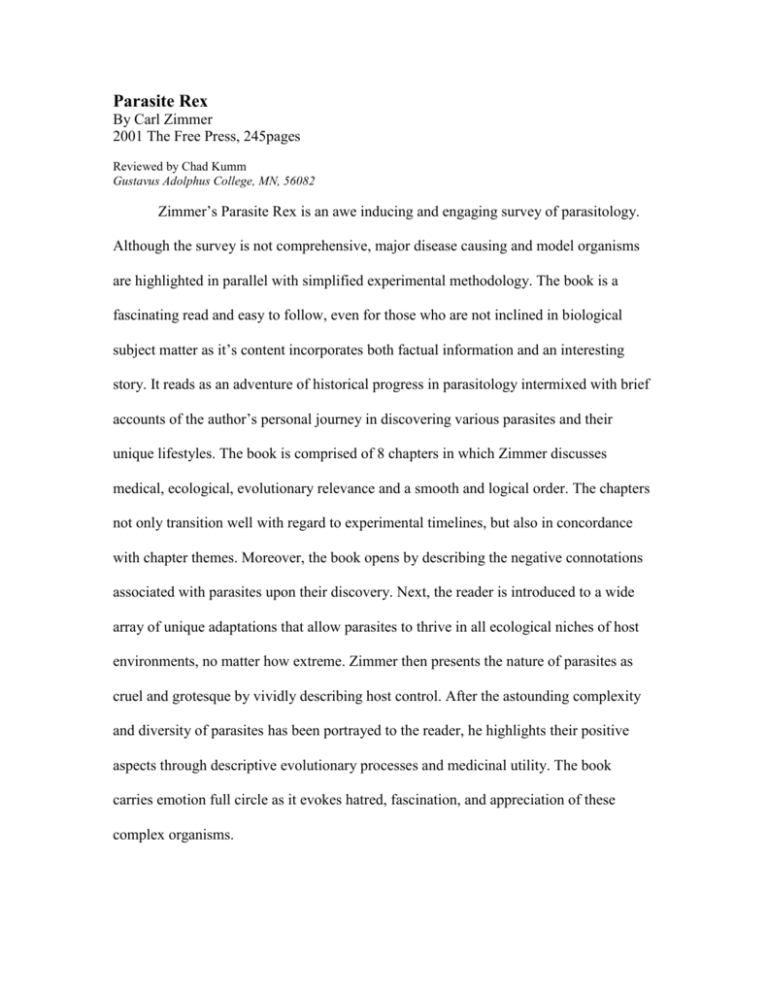
Parasite Rex By Carl Zimmer 2001 The Free Press, 245pages Reviewed by Chad Kumm Gustavus Adolphus College, MN, 56082 Zimmer’s Parasite Rex is an awe inducing and engaging survey of parasitology. Although the survey is not comprehensive, major disease causing and model organisms are highlighted in parallel with simplified experimental methodology. The book is a fascinating read and easy to follow, even for those who are not inclined in biological subject matter as it’s content incorporates both factual information and an interesting story. It reads as an adventure of historical progress in parasitology intermixed with brief accounts of the author’s personal journey in discovering various parasites and their unique lifestyles. The book is comprised of 8 chapters in which Zimmer discusses medical, ecological, evolutionary relevance and a smooth and logical order. The chapters not only transition well with regard to experimental timelines, but also in concordance with chapter themes. Moreover, the book opens by describing the negative connotations associated with parasites upon their discovery. Next, the reader is introduced to a wide array of unique adaptations that allow parasites to thrive in all ecological niches of host environments, no matter how extreme. Zimmer then presents the nature of parasites as cruel and grotesque by vividly describing host control. After the astounding complexity and diversity of parasites has been portrayed to the reader, he highlights their positive aspects through descriptive evolutionary processes and medicinal utility. The book carries emotion full circle as it evokes hatred, fascination, and appreciation of these complex organisms. The opening chapter describes the negative political and social views associated with the word “parasite”. Centuries of parasitic reputation was extracted from various cultures and their respective theological works and briefly overviewed by Zimmer. These perspectives are coupled with an interesting argument as it appears to motivate and set the stage for subsequent parasitologists and evolutionary reasoning. The best explanation that most early biologists could conjure up for the existence parasites was that they spontaneously generate inside the body. However, this notion was refuted by some biologists in that life was created by God in the first week and that all organisms were a reflection of his design and beneficence. Therefore, another external force that could induce parasites must be nonexistent as it was argued that every living species is an unbroken chain of parents and children. Today it is clear that parasites certainly do not spontaneously generate, and that they have highly ordered fluxes of host environments in their life cycles. Zimmer explains that the parasite was viewed as an untouchable mystery, especially without the proper tools to shed light on parasitic life cycles. The previous argument was eventually shattered by Fredrick Kuckenmeister, who initiated a serious of ground breaking discoveries in the field by observing certain parasites that were afflicting a non traditional/non cyclic host. Such organisms are in most circumstances confined to their grave, which he argued “defies the proposition of God’s benevolent harmony”. Kuckenmeister’s investigation and gruesome utilization of prisoners on death row to prove his point makes this a perfect anecdote for not only capturing the readers interest but also for preluding parasitic origin, function, and purpose. Zimmer immerses the reader into a broad spectrum of complex and intricate adaptations that allow parasites to survive and propagate whether they are unicellular or eukaryotic. Each species is fine tuned for a specific set of environments. If the reader didn’t know already, they soon discover that parasites are not just simple creatures that feed off tissue and resources of a host. In fact, parasites are portrayed as highly sophisticated and efficient masterminds that can exert transcriptional control over host cells, evade the immune system, and even manipulate the mind of a host organism in favor of the intruder. Moreover, they have evolved subtle interactions with the internal biochemistry of their victims exploiting cellular machinery for the parasite's own reproduction and also with their hosts. Take for example the Succulina, a free swimming larvae that is able to invade the exoskeleton of either male or female crabs. Once fertilized, the larvae progeny destroy the host’s reproductive system, altering hormonal equilibrium and subsequent behavior. The crab retains its inherent nurturing characteristics and facilitates the release of the progeny. Admittedly I was skeptical on the chemical modification to the host crab brain because, as Zimmer points out, the larval sack resembles that of a non afflicted crab in terms of its size and location. Therefore, the behavior of a crab may simply be a result of visual cues. As if Zimmer was anticipating skepticism he thoroughly explains many other examples of altered host behavior. In a serious of arguments he shows that parasites have mastered the vocabulary of their hosts’ hormones and neurotransmitters which are essential components for control at a behavioral level. Zimmer also documents parasites that make their victims more susceptible to predation such as the pill bug or stickle back. Although behavioral observations seem perfectly logical in assuming that parasites can form their hosts into their personal puppets, parasitologists are still trying to determine the chemical composition of signaling enhancing molecules secreted by various parasites. Difficulty in determining such molecules is likely attributed to the fact that a small signaling molecule is easily lost in a noisy environment full of traffic. His most compelling proposition of host control stems from cytological studies with the Gammarus. When infected with a parasite worm, the relationship demonstrates a positive correlation between serotonin, the parasitic hook worm, and latching behavior of the Gammarus. This ABC relationship is promising in that parisitologist are closing in on certain chemical pathways. The influence of parasites is all around us. Even with their unattractive physical appearance and horrifying abilities, the reader is finally able to get a taste of the positive effects of parasites. They play a key role in balancing niche carrying capacity and the balance between predators and their prey. Zimmer also gives many examples of symbiosis between parasite and plant species where the plant sacrifices little energy for either protection or aid in fertilization. Given that parasitism has many important aspects in environmental homeostasis, it has become known in recent years that parasitism is a significant driving force for evolution. The book reinforces this concept in presenting that 80 percent of known species parasitize in some fashion. The message that I believe Zimmer wants to portray is that parasites are more important than we think. They infect plants, animals, and humans and result in diseases such as malaria and elephantiasis, which have killed millions. Although we have the knowledge to stay clear and reverse our own afflictions, underdeveloped countries are struggling with many species, including flukes, tapeworms, and mosquitoes. Even in the West we are not completely parasite free as a great majority of us are afflicted with Toxoplasma. The chance that this particular parasite is dangerous is low but its chemical influence on the brain is currently being studied extensively. Parasites are evolutionary survivors and evolutionary drivers. While parasites must live in a world we’ve made, the opposite is also true. They have structured our ecosystems and quite possibly our human nature. After reading this book I find myself astounded with the biological significance of the parasite. Overall the book does a good job of giving examples that fit Zimmer’s arguments. Parasite Rex succeeds in describing evolutionary and reproductive mechanisms with an understandable level of detail for a large audience. However, I would have preferred if the physiological processes were covered more extensively in sections other than the immune system. Regardless, if you are looking for an interesting perspective on evolutionary processes and countless examples of reproductive efficiency, I recommend this book. It’s an eye opening experience.
